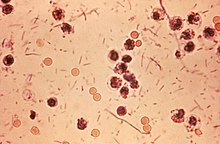
Back شيغيلا Arabic شيغيلا ARZ Шыгелы Byelorussian Shigel·la Catalan Shigella Czech Shigella Danish Shigella German Shigella Spanish Shigella Basque شیگلا Persian
| Shigella | |
|---|---|

| |
| Photomicrograph of Shigella sp. in a stool specimen | |
| Scientific classification | |
| Domain: | Bacteria |
| Phylum: | Pseudomonadota |
| Class: | Gammaproteobacteria |
| Order: | Enterobacterales |
| Family: | Enterobacteriaceae |
| Genus: | Shigella Castellani & Chalmers 1919 |
| Species | |
Shigella is a genus of bacteria that is Gram negative, facultatively anaerobic, non–spore-forming, nonmotile, rod shaped, and is genetically nested within Escherichia. The genus is named after Kiyoshi Shiga, who discovered it in 1897.[1]
Shigella causes disease in primates, but not in other mammals; it is the causative agent of human shigellosis.[2] It is only naturally found in humans and gorillas.[3][4] During infection, it typically causes dysentery.[5]
Shigella is a leading cause of bacterial diarrhea worldwide, with 80–165 million annual cases (estimated)[6] and 74,000 to 600,000 deaths.[6][7] It is one of the top four pathogens that cause moderate-to-severe diarrhea in African and South Asian children.[8]
- ^ Yabuuchi, Eiko (2002). "Bacillus dysentericus (sic) 1897 was the first taxonomic rather than Bacillus dysenteriae 1898". International Journal of Systematic and Evolutionary Microbiology. 52 (Pt 3): 1041. doi:10.1099/00207713-52-3-1041. PMID 12054222.
- ^ Ryan, Kenneth James; Ray, C. George, eds. (2004). Sherris medical microbiology: an introduction to infectious diseases (4th ed.). McGraw-Hill Professional Med/Tech. ISBN 978-0-8385-8529-0.[page needed]
- ^ Pond, Kathy (2005). "Shigella". Water recreation and disease. Plausibility of associated infections: Acute effects, sequelae and mortality. WHO. pp. 113–8. ISBN 978-92-4-156305-5. Archived from the original on June 30, 2013.
- ^ "Shigellosis" (PDF). European Association of Zoo and Wildlife Veterinarians. Archived from the original (PDF) on 2015-09-27.
- ^ Mims, Cedric; Dockrell, Hazel; Goering, Richard; Roitt, Ivan; Wakelin, Derek; Zuckerman, Mark, eds. (2004). Medical Microbiology (3rd ed.). Mosby. p. 287. ISBN 978-0-7234-3259-3.
- ^ a b Bowen A (2016). "Chapter 3: Infectious Diseases Related to Travel". The Yellow Book: Health Information for International Travel. CDC. ISBN 978-0-19-937915-6. Retrieved 22 June 2016.
- ^ Mani, Sachin; Wierzba, Thomas; Walker, Richard I (2016). "Status of vaccine research and development for Shigella". Vaccine. 34 (26): 2887–2894. doi:10.1016/j.vaccine.2016.02.075. PMID 26979135.
- ^ Kotloff, Karen L; Nataro, James P; Blackwelder, William C; et al. (2013). "Burden and aetiology of diarrhoeal disease in infants and young children in developing countries (the Global Enteric Multicenter Study, GEMS): a prospective, case-control study". The Lancet. 382 (9888): 209–222. doi:10.1016/S0140-6736(13)60844-2. PMID 23680352. S2CID 205969172.